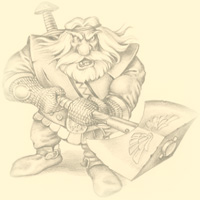|
Tile based
map.
by Vladimir
Vasilyev
translated
from russian by Yuliya Semenchenco
References:
The article based on the ideas by
David
Michael :
"Tile/Map-Based Game Techniques: Handling Terrain
Transitions"
Ivan Dyshlenko :
"Creation
map edit for strategy games like Warcraft"
Tile graphics was obtained from WarCraft II screenshots.
Part1.
The new
terms.
Further term
tile will be used also for a bits
representation of a graphic image. (Probably now it`s hard to understand,
but I am sure, that in
the necessary place of the text you will understand everything, about what
is going on, if you are not - write me.)
Type of a surface - WATER, GROUND, WOOD, STONES, BOGS etc.
Introduction.
Beginning work with the editor of map, first of
all, it will be necessary to define the laws on which game objects
will be cooperate with each other in the created game world, how they can
settle down on a game field as to each other and as to the borders
of the game world. Not all of them directly are needed for
creation of the map, but the map - not the end in itself. The created
model should correlate with sprite engine, which can work with this
map.
Model of the game
world.
In this passage the following model is
examined :
1. The game map consists of the
tiles.
2. Any tile can consist no more than of two
types of surface.
3. Each type of
surface can border with one or two STRICTLY determinated
types of surface.
The given model will essentially allow to reduce the amount
of the original tiles, which are necessary for creation of the map.
Let`s accept the following order of arrangement of the types of
surface:
WATER - GROUND - GRASS -
WOOD. (see fig.
1)
Fig. 1

According to our rules WATER can border
only on GROUND and WOOD only on GRASS.
The
new terms.
For any tile,
consisting of two types of surfaces, a type of surface which was situated
in the earlier accepted order of arrangement more to the
left, we shall call as low type,
more to the right - high
type.
Similarly it`s defined the "seniority" for two any other chosen types of surfaces.
The mathematical model.
Now we came to the most interesting part- how
transform our model to the language of numbers. If we imagine,
that our map is already constructed, (look at fig. 2) is easy to understand, that
any tile is undoubtfully defining by its nearest neighbours.
There are 8 of such neighbours. The number 8 by itself should
already inspire you with optimism - you can
completely describe tile in one byte. But ahead of we can expect for more
pleasant coincidences. From 8 neighbours 4 of them border on the
corners and 4 - on the sides of chosen tile. 4 is a half-byte, and
it can be easy to receive access, as well as to byte!
So, we can describe any tile
by 8 bits. LOW 4 bits we use for the
description of the sides, HIGH 4
bits for the description of the corners. (look at
fig. 3-4)
| Fig.
2 |
Fig.
3 |
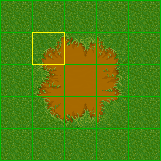 |
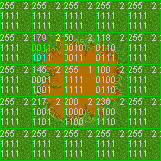 |
If you don`t know the exact meaning of the word "bit",especially for you here is prepared the
demonstration program Bit
manipulation demo.
| Fig.
4 |
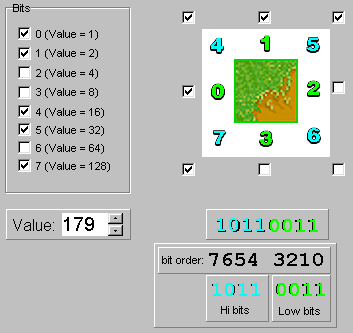 |
Thus, it will be a logical thing to define the following
order according to which the nearest neighbours of the chosen
tile will be checked and to establish precisely the same
proportion between the order of following(?) of bits and
numeration of the edges(sides) and tops(apexes). The order you can see at
a fig. 5 (at the left), and proportion between the order of following(?) of bits
and by apexes and edges(sides) in the fig. 5 (at the centre).
The considered tile is painted in light green, the nearest
neighbours - in light blue.
Fig. 5: Direction and checking bit
correlation.
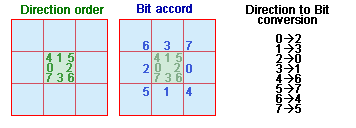
It is necessary to notice, that for the constructed
self-coordinated map:
bit 0 is equal bit 2
bit 1 is equal
bit 3
bit 2 is equal bit 0
bit 3 is equal
bit 1
Etc....- Since there should be identical types of
surfaces.
As it was defined earlier, any tile can
include no more than two types of surfaces. Thus one type of
surface is considered as Low type, another -
as Hi type.
For Hi type will correspond
to 1 and for Low type -to
0.
Designing of
sets
The new
terms.
The brush of a set or its name is
defined by HI type of the tiles.
Due to item 3 of our model,we need only three sets of the tiles for a map creation with four types of
surface:
SET1 for
transition(transformation) WATER - GROUND (brush "ground" =
1)
SET2 for transition GROUND - GRASS
(brush "grass" = 2)
SET2 for transition
GRASS - WOOD (brush "wood" =
3)
As long as all sets are arranged equally, we
shall consider the certain generalized set WHITE -BLACK
for a map construction with two types of surfaces - white and
black.
Accurately examine all possible
combinations of the arrangement of types of surfaces on borders of
the tiles we shall find out that the edges(sides) and corners(apexes) and their
bit representations can be arranged in ordinary binary manner:
0000,0001,0010 and so on...
a fig. 6: Common terrain transition bit model.

Moreover, it is possible to reduce amount of
the original tiles for a set changing its graphics. Notice, that the mathematical representation of the
such tiles do not change!!! Compare fig. 6
and fig. 7.
Fig. 7:
Reduced terrain transition bit model.

The real GROUND - GRASS set, based on a stated
above technique, which is given below .
Fig. 8:
Real terrain tile set.


Copyright ®
2001-2002 Vladimir Vasilyev.
Any part of
given clause, including illustrations, in any purposes can not
be reproduced in any form and any means without the written
permission of the author.
| 